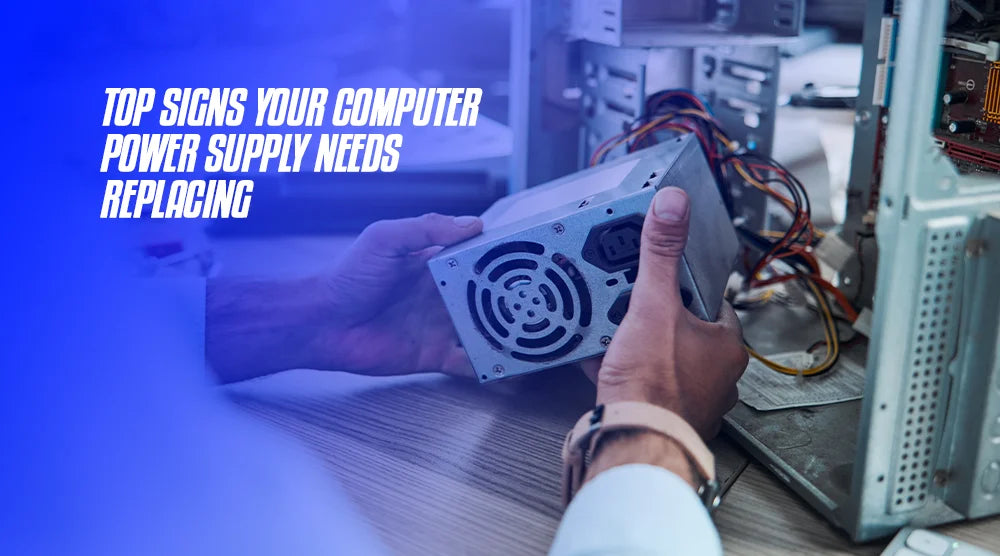Many users often overlook one of the most critical components of a computer’s performance and stability: the Computer Power Supply.
Quietly powering every part of your system, the PSU plays a vital role behind the scenes. Yet when it starts to fail, it can cause frustrating issues or permanent hardware damage.
Whether you're a casual user or a dedicated gamer, recognizing the signs of a failing PSU is vital to prevent costly repairs and downtime. In this blog, we’ll dive into why reliable PSU matters, the common symptoms of PSU failure, and what to look for when choosing a suitable replacement.
Let's get started!
What Is A Computer Power Supply?
Your computer's electrical system revolves around the computer power supply, which transforms AC power from your wall outlet into the low-voltage DC needed by your components.
Major Uses of a PSU:
-
Provides power to the CPU, GPU, motherboard, drives, fans, and peripherals.
-
Controls voltage to guarantee consistent performance.
-
Offers over-voltage, under-voltage, and short-circuit protection among other safety measures.
Investing in a dependable PSU guarantees a regular voltage supply and shields against electrical faults or power surges. A low-quality PSU might impair your PC's performance and lifespan.
8 Signs Your Computer Power Supply Needs Replacement
A bad PSU might impersonate other hardware problems, hence diagnosing is challenging. The most often encountered signals your computer power supply might be near to expire are given here.
1. Frequent Random Restarts or Shutdowns
Particularly during gaming or rendering, unexpected shutdowns or reboots usually point to symptoms of PSU failure. During peak loads, your PSU might not have adequate power.
2. Unpleasant Noises or Burning Smell
Your PSU could be overheating or having internal component failure if you detect burning plastic or hear odd buzzing, cracking, or clicking sounds. These are warnings with great urgency.
3. PC Fails to Turn on or Needs Several Tries
Even with a working motherboard and RAM, you find it difficult to switch on your computer? A defective PSU may give erratic power or not start the power-on sequence.
4. BSODs or System Freezes (Particularly Under Heavy Load)
Particularly during demanding activities like gaming, streaming, or video editing, underpowered components can cause random freezes or Blue Screen of Death (BSOD) errors.
5. Damaged Visible: Fraying Wires or Bulging Capacitors
Open your PSU casing only if you are skilled and examine for:
-
Leaking or swelled capacitors.
-
Marks from burns.
-
Melted or frayed cables.
Clear indications point to the time to replace a malfunctioning PSU.
6. Overheating or PSU Fan Not Turning
Heat accumulation results from a dead or loud fan since it cannot cool your PSU. Overheating not only affects the PSU but also might damage other components.
7. Irregular Peripheral Power
Voltage instability, another sign of PSU failure, shows itself as either erratic USB device disconnecting or receiving inadequate power.
8. Software Tool Detected Voltage Irregularities
Using tools like HWMonitor or Open Hardware Monitor can spot unstable voltage variations, therefore verifying PSU problems without opening the case.
Reasons Why Replacing a Faulty PSU Is Absolutely Necessary
Ignoring PSU problems can result in more than a frozen screen.
Threats from a Subpar PSU:
-
Permanent hardware damage (motherboard, GPU, SSD).
-
During shutdowns, damaged or lost data.
-
In rare situations, electrical fires.
Advantages of Early Replacement:
-
Better stability of systems.
-
Better energy efficiency and less noise.
-
Knowing your computer is secure gives you peace of mind.
-
Swapping a broken PSU before failure spares you from serious pain and costly repairs.
How One Chooses a Replacement Computer Power Supply?
Keep these points in mind when buying a replacement PSU:
1. Determine your Wattage Requirements.
Use online PSU calculators such as OuterVision to find the right wattage depending on your parts and consumption.
2. Look for 80+ Certification.
Efficiency scores like 80+ Bronze, Silver, Gold, or Platinum help to guarantee less energy waste and lower heat generation.
3. Choose Modular or Non-Modular.
- Great for cable management, modular PSUs allow you to utilize only the cables you require.
- The non-modular PSUs are more inexpensive but disorganized.
- Long-term dependability and future upgrading possibilities are provided by a good computer power supply.
Wrap Up
Your computer's power supply may seem like just a small box, but it plays a huge role in your system's overall health. If you’ve experienced any of the warning signs like strange noises, unexpected shutdowns, or instability, it’s time to take a closer look at your PSU. Replacing a faulty power supply early can protect your components, boost performance, and keep your setup running smoothly and safely.
Need expert help in building your dream PC?
Visit Technoid Inc. today and start building your custom rig with the right components, including the perfect PSU, all backed by expert advice and support.
Power up your performance with a PC built just for you!
Frequently Asked Questions
1. Can a failing PSU damage other components?
Yes. Your motherboard, GPU, and storage devices may be harmed by the unstable voltages a poor PSU sends.
2. How long does a power supply last?
A decent PSU should survive 5–10 years; cheap or heavily used units may fail earlier.
3. What is the safest method of testing PSU?
To avoid electrical hazards, use a multimeter or PSU tester. Ask a technician if you have any doubts.
4. Should I change my PSU if I increase my GPU?
Yes, your new GPU's power needs could surpass what your present PSU can provide. Before improving, always compute the overall wattage required.

 United States
United States

